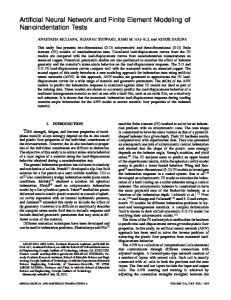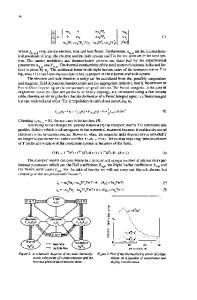Finite element study for nanoindentation measurements on two-phase materials
- PDF / 1,906,715 Bytes
- 9 Pages / 612 x 792 pts (letter) Page_size
- 34 Downloads / 346 Views
Horst Vehoff Materials Science, Saarland University, Saarbrücken, Germany (Received 16 June 2003; accepted 3 September 2003)
Finite element simulations of conical indentations in two-phase elastic–plastic materials were used to investigate the influence of the shape and the aspect ratio of particles embedded in a matrix material on the deformation behavior and hardness during depth-sensing indentation. Starting with single-phase materials, pile-up behavior and its influence on the contact area was studied. Particle–matrix systems were simulated for elastic–perfectly plastic particles embedded in a matrix, with a yield-strength ratio of 2 or 0.5, respectively. The simulations were motivated by indentation experiments in precipitation hardened nickel-base superalloy with a nanoindenting atomic force microscope. In the studied alloys, the matrix formed channels with a thickness of about 100 nm around the precipitates with diameters of about 500 nm. The simulations explained an experimentally observed transition from particle to matrix deformation behavior during indentation. Depth limits in hardness testing in particle–matrix systems were evaluated. Depending on the aspect ratio, soft and hard particles were tested reliably up to a normalized contact radius of about 70% particle diameter.
I. INTRODUCTION
Depth-sensing indentation, or nanoindentation, is a well-established method for measuring the micromechanical properties of small nanometer volumes.1 The technique has shown its value, for example, in the study of thin film properties in the field of semiconductor industries. Nanoindentation experiments on thin films do not require a high lateral resolution, so that tip positioning is not important and can be controlled by light microscopy. In alloys with nanoscale constituents, lateral positioning becomes more important and requires a high lateral resolution. The combination of a nanoindenter and an atomic force microscope then assures the proper positioning of the indenting tip on different phases in the alloy.2 To image small phases, metallographic preparation techniques have been developed and the atomic force microscope has been compared to standard imaging techniques.3 The nanoindenting capabilities of evaluating the properties of individual phases have been demonstrated for example on transformation induced plasticity (TRIP) steels4 and lamellar TiAl alloys.5 Another important class of two-phase materials are nickel-base superalloys. In single-crystalline nickel-base superalloys, the soft nickel matrix is hardened by coherently embedded ␥⬘ precipitates with a nominal composition of Ni3(Al,Ti, . . .). To evaluate correctly indentation tests in two-phase materials and to determine depth limits for J. Mater. Res., Vol. 19, No. 1, Jan 2004
http://journals.cambridge.org
Downloaded: 18 Mar 2015
hardness testing, finite element simulations were conducted. In thin film testing, a depth limit is given by the indentation depth divided by the film thickness. An often-used rule of thumb limits the maximum indentation
Data Loading...











